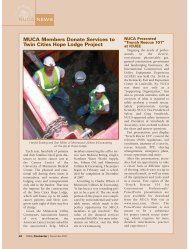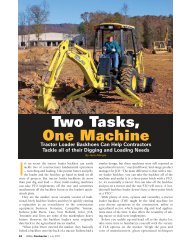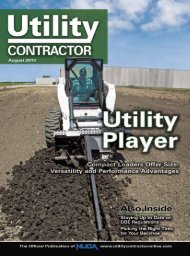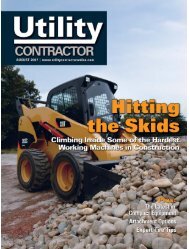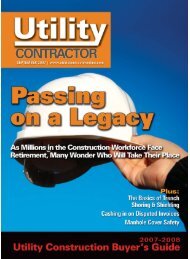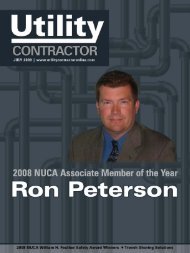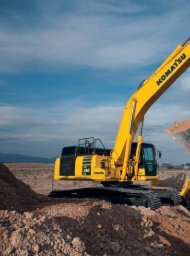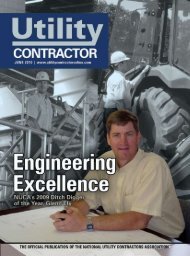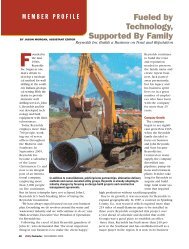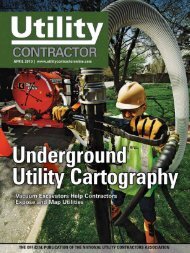View Full May PDF Issue - Utility Contractor Online
View Full May PDF Issue - Utility Contractor Online
View Full May PDF Issue - Utility Contractor Online
Create successful ePaper yourself
Turn your PDF publications into a flip-book with our unique Google optimized e-Paper software.
SAFETY MANAGEMENT<br />
that contractors regularly test the air in the pit and ventilate<br />
when necessary.<br />
Confined Space Entry<br />
On occasion it may be necessary to retract the auger and<br />
require a worker(s) to enter the casing to check the line and<br />
grade or to remove an obstruction. Whenever a worker(s)<br />
must enter the casing the situation must be treated as a confined<br />
space entry and the atmosphere must be tested prior to<br />
and during entry into the casing. The casing will also have<br />
to be ventilated with a blower and lighting provided. Anklets<br />
attached to a proper retrieval line should be attached to the<br />
workers in case a rescue becomes necessary.<br />
Material Handling<br />
Machinery, pipes, augers, spoil material and the like must<br />
be moved around, into and out of the boring pit. Each job is<br />
different and may require a different type of plan for material<br />
handling. Start by making sure that the equipment that will be<br />
used to lift and handle material is in good condition, starting<br />
with the crane or excavator. Daily inspections must be performed.<br />
Riggers should be instructed how to inspect and use<br />
slings and the different types of hitches to use so that a pipe or<br />
auger or some other object does not slip out of the sling and<br />
fall on workers below in the pit. Make sure the slings are rated<br />
to handle the weight of the load.<br />
Casings are generally lifted and lowered into the trench<br />
with the auger inside the casing; therefore it should be secured<br />
inside so that it does not slip out. In addition to lifting<br />
and lowering materials, pipes and augers must be set in place.<br />
During these operations workers should be aware of the pinpoint<br />
hazards when connecting the casings or attaching the<br />
augers. Tag lines should be used to control loads and keep<br />
them from swinging out of control. Workers should be directed<br />
to stand to one side and out from under loads as they<br />
are lifted into and out of the pit.<br />
Welding<br />
All the typical hazards associated with welding operations<br />
exist with one added factor — welding is being performed in<br />
an enclosed space. Depending on the size of the casing or pipe<br />
to be welded, one or two welders will be required to perform<br />
the task. They must be equipped with welding hoods, proper<br />
eye protection and welder’s leathers. Other workers who remain<br />
in the pit will also have to have proper eye protection<br />
to prevent flash burns. Some contractors provide a welding<br />
screen to block the rays from exposed workers; others require<br />
unnecessary personnel to exit the pit during welding<br />
operations. Ventilation, preferably local exhaust ventilation in<br />
deep trenches, must be provided to ensure that a safe atmosphere<br />
exists in the pit.<br />
Other typical welding and cutting precautions will have to<br />
be in place such as properly storing and capping gas cylinders,<br />
removing gas hoses from the pit when not in use, grounding<br />
arc welding machines and using connectors that are not damaged.<br />
Remember that arc welding in a wet or damp environments<br />
increases electrical hazards, which is why it is so important<br />
to ensure that welding cables are in good condition and<br />
free from cuts and splices. Note: OSHA 1926.353(b) requires<br />
ventilation when welding or cutting in a confined space.<br />
HEB Machine<br />
Qualified and skilled HEB machine operators are key to<br />
the success of any pipe boring operation. They must have<br />
a feel for operating the machine because they cannot see<br />
what is in front of the auger even after core soil samples<br />
have been analyzed and bore charts provided. If the auger<br />
hits an undetected object and the operator does not realize<br />
that the machine’s torque is increasing, it is possible<br />
for the machine to tilt or flip over. Employees working in<br />
the pit must understand the potential hazards of working<br />
near the machine and take the appropriate precautions —<br />
e.g., keeping their hands and feet where they cannot be<br />
pinched between the rail and the pipe and other pinch<br />
points. They must also stay out from in front of the spoil<br />
ejection chute, especially when the bore takes place in<br />
gravel and sandy soil conditions. Workers should also be<br />
required to wear eye protection at all times.<br />
Work Zones<br />
Because HEB is often performed in areas near roadways,<br />
traffic control is a major consideration. <strong>Contractor</strong>s<br />
should refer to the Manual of Uniform Traffic Control Devices<br />
(MUTCD) — Part VI when setting up work zones. Jersey barriers<br />
and other traffic control devices should comply with<br />
the requirements established by the MUTCD. Many DOT<br />
jobsites require workers to wear high visibility clothing —<br />
either Class II or III. It should fit properly and be properly<br />
secured to ensure visibility and eliminate the possibility of it<br />
being caught in moving machinery.<br />
For more information about auger boring and other trenchless<br />
methods, consult NUCA’s Trenchless Construction Methods<br />
and Soil Compatibility Manual, which is available through the<br />
NUCA Store at www.nuca.com.<br />
Note: Since in some cases there are no specific regulations or<br />
even industry-wide best practice recommendations regarding HEB<br />
hazard control, I asked several NUCA contractor members for<br />
suggestions. The NUCA contractor members consulted in the writing<br />
of this article were: Brandon Young, Vice President of Operations,<br />
Miller the Driller, Des Moines, Iowa; Jim Gonzales, Gonzales<br />
Boring & Tunneling Inc., North Plains, Ore.; LD Alexander, Safety<br />
Director, RMCI Inc., Albuquerque, N.M.; and Greg Strudwick,<br />
President, Greg Strudwick & Associates, Coppell, Texas.<br />
Please keep in mind that the efficacy of the suggestions may vary<br />
based on the type, depth, soil condition and area of the country<br />
where the work is performed.<br />
George Kennedy is NUCA Vice President of Safety.<br />
<strong>May</strong> 2009 | <strong>Utility</strong> <strong>Contractor</strong> 109<br />
National <strong>Utility</strong> <strong>Contractor</strong>s Association




